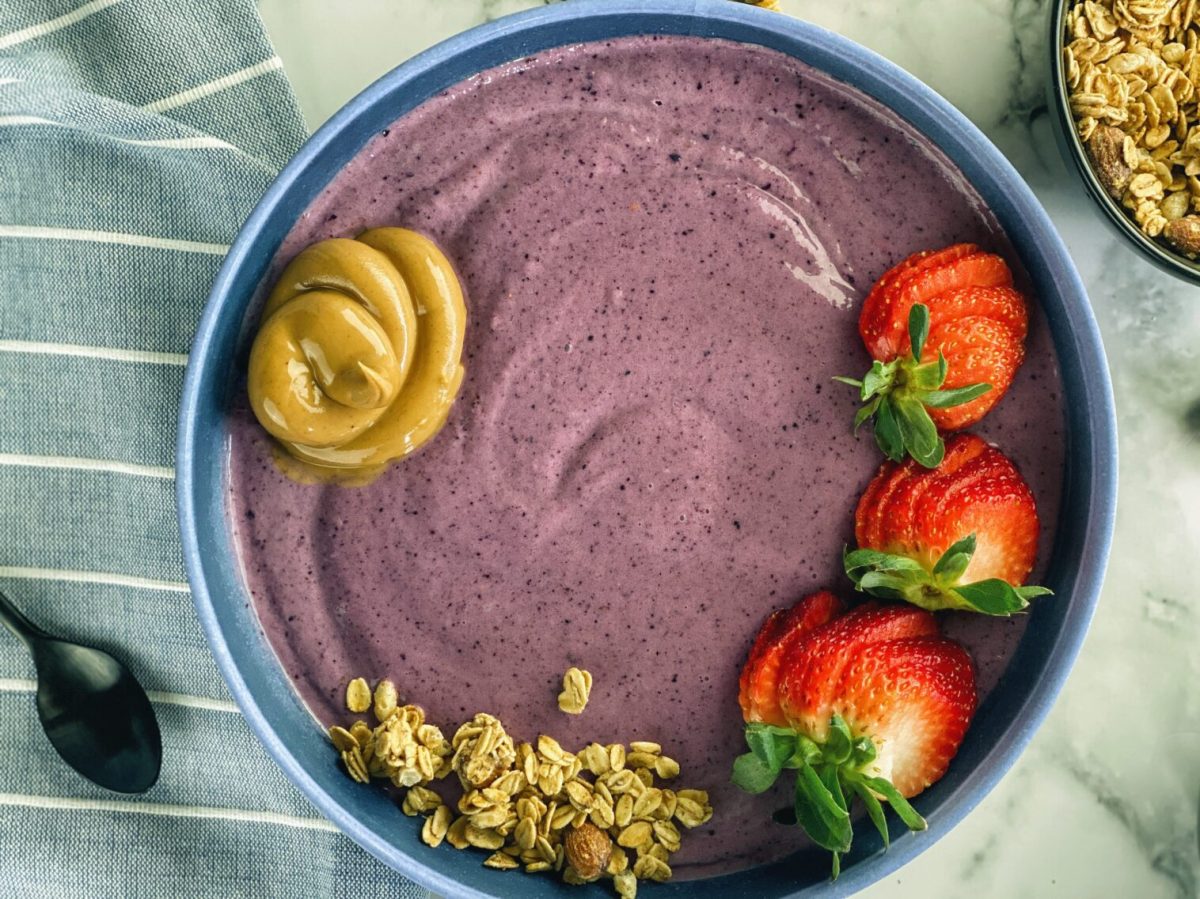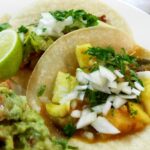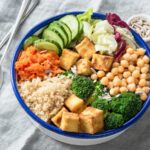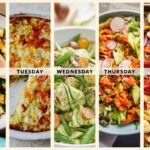Dive into the vibrant world of flexitarian eating with this guide to crafting protein-packed smoothie bowls. Imagine a breakfast, lunch, or even dessert that’s both incredibly delicious and surprisingly nutritious. We’ll explore a rainbow of fresh, seasonal ingredients, transforming them into creamy, textured masterpieces. From selecting the perfect protein boost to mastering the art of layering visually stunning toppings, this journey promises to elevate your smoothie game to a whole new level. Prepare to be inspired by unique flavor combinations and discover the simple secrets to creating smoothie bowls that are as good for your body as they are for your soul.
This comprehensive guide will walk you through each step, from choosing the best protein sources and base liquids to perfecting the art of layering and creating visually appealing designs. We’ll explore diverse flavor profiles, provide detailed recipe instructions, and offer valuable nutritional information, all while emphasizing the flexibility and deliciousness of flexitarian eating. Get ready to unleash your creativity and enjoy the satisfying journey of crafting your own personalized protein-packed smoothie bowls.
Ingredient Selection for a High-Protein Flexitarian Smoothie Bowl
Crafting a vibrant and nutritious flexitarian smoothie bowl hinges on selecting the right ingredients. A balanced blend of fruits, vegetables, and protein sources is key to creating a satisfying and energy-boosting meal replacement or snack. This section will explore five excellent protein sources, highlighting their nutritional benefits and considering potential allergens. We will also discuss the importance of incorporating seasonal produce for optimal flavor and nutrient density.
Choosing the right protein source is crucial for maximizing the nutritional value of your smoothie bowl. A variety of options exist, allowing for customization based on dietary preferences and availability. The following five protein sources offer a good balance of protein, fiber, and other essential nutrients.
Five Flexitarian-Friendly Protein Sources
These protein sources offer a diverse range of nutritional benefits and cater to various dietary needs and preferences. Consider their individual strengths when crafting your smoothie bowl recipe.
- Greek Yogurt: A powerhouse of protein, Greek yogurt provides a creamy texture and tangy flavor to smoothie bowls. It’s also a good source of calcium and probiotics, beneficial for gut health. A typical serving offers approximately 20 grams of protein.
- Chia Seeds: These tiny seeds are nutritional dynamos, boasting a remarkable amount of protein and fiber. They also provide omega-3 fatty acids and are an excellent source of antioxidants. One ounce of chia seeds packs around 4 grams of protein and 10 grams of fiber.
- Peanut Butter (or other nut butters): A classic addition to many smoothie bowls, peanut butter adds creaminess, protein, and healthy fats. It’s important to choose varieties without added sugar or salt. Two tablespoons of peanut butter typically contain around 7 grams of protein.
- Hemp Seeds: Hemp seeds are a complete protein source, meaning they contain all nine essential amino acids. They also offer a good source of healthy fats, fiber, and minerals. One ounce of hemp seeds provides roughly 10 grams of protein.
- Soy Milk (unsweetened): A plant-based protein source, soy milk provides a smooth consistency and adds protein to your smoothie bowl. Choose unsweetened varieties to minimize added sugar. One cup of unsweetened soy milk usually contains around 7 grams of protein.
Comparison of Protein Sources
The following table provides a direct comparison of the five protein sources, highlighting their protein and fiber content, as well as potential allergens.
| Protein Source | Protein (per serving) | Fiber (per serving) | Potential Allergens |
|---|---|---|---|
| Greek Yogurt (1 cup) | ~20g | ~0g | Dairy |
| Chia Seeds (1 oz) | ~4g | ~10g | None |
| Peanut Butter (2 tbsp) | ~7g | ~2g | Peanuts |
| Hemp Seeds (1 oz) | ~10g | ~1g | None (rare allergies exist) |
| Soy Milk (1 cup) | ~7g | ~1g | Soy |
Importance of Seasonal Fruits and Vegetables
Incorporating seasonal fruits and vegetables into your smoothie bowls offers numerous advantages. Seasonal produce is generally at its peak flavor and nutritional value. Fruits and vegetables harvested during their optimal growing season are richer in vitamins, minerals, and antioxidants. This translates to a more flavorful and nutritious smoothie bowl. For example, using peak-season strawberries in a smoothie bowl will deliver a far more intense and vibrant strawberry flavor compared to strawberries grown out of season.
Base Liquid and Thickening Agents for Optimal Texture

The choice of base liquid and thickening agent significantly impacts the final texture and flavor of your flexitarian smoothie bowl. The base liquid provides the foundation, influencing both the consistency and taste, while the thickening agent transforms a thin blend into a spoonable delight. Careful consideration of both elements is crucial for achieving the perfect creamy, satisfying texture.
Base Liquid Selection and its Impact
The base liquid forms the backbone of your smoothie bowl, contributing significantly to its overall consistency and taste. Different options offer unique textural and flavor profiles. Almond milk, for instance, lends a subtly nutty flavor and a relatively thin consistency, perfect for those who prefer a lighter bowl. Coconut water, on the other hand, imparts a tropical sweetness and a slightly thicker, more refreshing texture. Yogurt, whether dairy or non-dairy, adds a significant creamy element and a tangy note, resulting in a richer, more decadent bowl. The choice depends on your preferred flavor profile and desired texture; a thinner base allows for greater emphasis on the toppings, while a thicker base creates a more substantial, self-standing bowl.
Thickening Methods: Frozen Fruit, Chia Seeds, and Nut Butter
Three primary methods effectively thicken smoothie bowls, each with its own set of advantages and disadvantages. Frozen fruit offers a natural, flavorful thickening agent, seamlessly integrating into the blend. Chia seeds provide a subtle, slightly gelatinous texture, and add a nutritional boost. Nut butter contributes a rich, creamy consistency and intense flavor, but can overpower more delicate ingredients.
Frozen Fruit Thickening: A Naturally Sweet Approach
This recipe variation utilizes frozen berries for both sweetness and thickening. The intensely cold berries create a naturally thick, slightly icy texture. Imagine a vibrant bowl, bursting with the deep purple of frozen blueberries and the ruby red of frozen raspberries. The slight ice crystals add a refreshing contrast to the creamy texture of the yogurt base. The recipe would use a base of unsweetened almond milk and Greek yogurt, blended with a generous portion of mixed frozen berries. The resulting bowl possesses a naturally sweet, slightly tart flavor, with a refreshing, slightly icy texture.
Chia Seed Thickening: A Smooth and Silky Texture
This variation incorporates chia seeds for a smoother, silkier consistency. Picture a bowl with a luxuriously smooth texture, a subtle nutty flavor from the chia seeds mingling with the creamy coconut milk base. The chia seeds, while adding thickness, don’t significantly alter the flavor profile, allowing other ingredients to shine. This recipe would start with coconut water as the base, combined with a scoop of your favorite protein powder and a tablespoon of chia seeds. The resulting texture is incredibly smooth and creamy, almost pudding-like, with a slightly nutty undertone.
Nut Butter Thickening: A Rich and Decadent Experience
This recipe uses almond butter for a rich, decadent texture and intense nutty flavor. Visualize a bowl with a thick, luxurious consistency, the deep golden brown of the almond butter swirling through the creamy base. The almond butter adds a substantial creaminess and a pronounced nutty flavor, potentially overpowering more subtle ingredients. This recipe uses a base of unsweetened almond milk and a generous spoonful of almond butter, blended with a small amount of frozen banana for sweetness and additional thickening. The resulting bowl is exceptionally rich and creamy, with a strong almond flavor that dominates the overall taste profile.
Flavor Combinations and Creative Toppings
Crafting a truly exceptional flexitarian smoothie bowl involves more than just blending ingredients; it’s about orchestrating a symphony of flavors and textures that tantalize the taste buds and delight the eyes. The right combination of fruits, vegetables, and protein sources can create a vibrant and nutritious meal replacement or a satisfying snack. Thoughtful topping choices elevate the experience, adding visual appeal and textural contrast.
The following sections explore unique flavor combinations and visually appealing toppings, guiding you towards creating truly unforgettable smoothie bowls.
Three Unique Flexitarian Smoothie Bowl Flavor Combinations
These flavor combinations showcase the versatility of flexitarian eating, offering a delightful balance of sweetness, tartness, and savory notes. Each combination prioritizes high-protein ingredients to ensure a satisfying and sustained energy boost.
- Tropical Mango Tango: This vibrant bowl features the sweetness of ripe mango blended with creamy coconut milk, a scoop of vanilla protein powder, and a handful of spinach for a hidden boost of nutrients. The mango’s sweetness complements the subtle coconut flavor, while the spinach adds a touch of earthiness without compromising the tropical vibe. The protein powder provides a thick, creamy texture and boosts the protein content significantly. Imagine the bright yellow-orange hue of the mango contrasting with the deep green of the spinach, a visually stunning combination.
- Berry Beet Blast: This combination blends the earthy sweetness of roasted beets with the tartness of mixed berries (strawberries, blueberries, raspberries) and a dollop of Greek yogurt for extra protein and creaminess. The roasted beets add a subtle sweetness and beautiful deep crimson color, while the berries provide a burst of tartness and juicy texture. The Greek yogurt adds a cool, tangy contrast and provides a substantial protein boost. The visual effect is a rich, jewel-toned bowl, a captivating mix of deep reds and vibrant purples.
- Chocolate Peanut Butter Powerhouse: A decadent yet healthy option, this bowl combines the richness of cocoa powder with creamy peanut butter, banana for sweetness, and a scoop of chocolate protein powder. A tablespoon of chia seeds adds both nutritional value and a pleasant textural element. The chocolate and peanut butter create a classic flavor combination, while the banana provides natural sweetness and creaminess. The chia seeds add a subtle crunch and boost the omega-3 fatty acids. Imagine the deep brown of the chocolate contrasted with the creamy tan of the peanut butter and the pale yellow of the banana, a visually appealing and satisfying combination.
Visually Appealing and Flavorful Toppings for Flexitarian Smoothie Bowls
Toppings are crucial for enhancing both the visual appeal and the textural complexity of your smoothie bowl. The following suggestions offer a diverse range of flavors and textures.
- Toasted Coconut Flakes: These add a delicate sweetness and a satisfying crunch, providing a delightful textural contrast to the smooth base. The light brown flakes offer a visually appealing contrast against many smoothie bowl colors.
- Pumpkin Seeds: Their subtle nutty flavor and firm texture offer a satisfying contrast to the creamy base. The pale green color of the seeds adds a touch of visual interest.
- Sliced Almonds: These add a nutty flavor and a satisfying crunch, while their light brown color provides visual contrast. Their slightly oily texture adds another layer of sensory experience.
- Fresh Berries: Their vibrant colors and juicy textures provide a refreshing contrast to the creamy base, enhancing both the visual appeal and flavor profile. The variety of colors adds a vibrant and eye-catching element.
- Shredded Cacao Nibs: These add a bittersweet chocolate flavor and a pleasant crunch, offering a sophisticated touch. Their dark brown color provides a visual contrast and a hint of elegance.
Step-by-Step Recipe Creation and Visual Guide
This recipe guides you through creating a vibrant, high-protein flexitarian smoothie bowl, focusing on both taste and visual appeal. Each step is designed to build a layered masterpiece, showcasing the beauty of fresh ingredients while delivering a satisfyingly nutritious meal. The process emphasizes simple techniques for achieving a professional-looking result.
Recipe: High-Protein Flexitarian Smoothie Bowl
This recipe yields one large smoothie bowl.
- Prepare the Ingredients (Visual: A colorful array of fruits, vegetables, and protein sources on a clean countertop.) Begin by washing and prepping all ingredients. This includes chopping the mango (approximately 1 cup, diced), slicing the strawberries (½ cup, sliced), and measuring out the spinach (1 cup, packed), Greek yogurt (½ cup, plain, nonfat), chia seeds (1 tablespoon), and protein powder (1 scoop, vanilla or unflavored). The scene is bright and cheerful, highlighting the freshness of the produce.
- Blend the Base (Visual: A high-powered blender humming, the contents swirling into a vibrant green hue.) Combine the spinach, Greek yogurt, chia seeds, protein powder, and ½ cup of your chosen liquid (almond milk recommended) in a high-powered blender. Blend until completely smooth and creamy, scraping down the sides as needed. The mixture transitions from a chunky, uneven green to a vibrant, almost emerald, smooth consistency.
- Layer the Bowl (Visual: A wide, shallow bowl is gradually filled with carefully placed ingredients.) Pour the blended mixture into a wide, shallow bowl. The base layer is a deep, verdant green, thick and luscious. It sits in the bowl like a smooth, polished emerald.
- Add Toppings (Visual: A cascade of colorful fruits and nuts adorning the green base.) Arrange the diced mango in a circular pattern around the edge of the bowl, creating a sunny yellow border against the green. Next, carefully place the sliced strawberries amongst the mango, adding pops of bright red. Sprinkle the remaining chia seeds and a handful of chopped almonds (¼ cup, roughly chopped) over the top for added texture and visual interest. The bowl now explodes with color and texture – a vibrant tapestry of green, yellow, and red, punctuated by the creamy white yogurt peeking through and the speckled brown of the chia seeds and almonds.
- Final Touches (Visual: A final sprinkle of granola and a drizzle of honey add the finishing touches.) Finish with a light dusting of granola (¼ cup) and a delicate drizzle of honey (1 teaspoon) for a touch of sweetness and visual appeal. The granola adds a layer of rustic charm and crunchy texture, while the honey creates a glossy sheen and a subtle, golden hue.
Blending Techniques for Optimal Texture
Proper blending is crucial for achieving a smooth and creamy texture. Start with liquids first, then add softer ingredients before incorporating harder ones. Blend in stages, pausing to scrape down the sides as needed, to ensure everything is thoroughly incorporated. Over-blending can lead to a watery consistency; under-blending will leave you with chunks. The goal is a perfectly smooth, yet slightly thick base that provides the ideal foundation for your toppings.
Layering for Visual Appeal
Strategic layering enhances the aesthetic appeal of the smoothie bowl. Start with the base layer, ensuring it’s evenly distributed. Then, arrange toppings in a visually pleasing manner, considering color contrast and texture variations. Think of it as creating a miniature work of art, using food as your medium. Consider using a piping bag for a more professional look with certain toppings.
Creating flexitarian smoothie bowls brimming with extra protein is not just about nutrition; it’s about a sensory experience. The vibrant colors, the delightful textures, and the explosion of flavors combine to create a truly satisfying and healthy meal or snack. By mastering the techniques and exploring the endless possibilities of ingredient combinations, you’ll unlock a world of creative culinary freedom. So, gather your ingredients, unleash your inner artist, and embark on a delicious adventure of crafting personalized smoothie bowls that nourish your body and delight your senses. Enjoy the process, and savor every creamy, delicious bite!
FAQ Guide
What are some common mistakes to avoid when making smoothie bowls?
Over-blending can create a watery consistency. Using too much liquid can also lead to a thin bowl. Conversely, not using enough liquid can result in a very thick, difficult-to-blend mixture. Finally, adding toppings before the bowl is sufficiently chilled can cause them to melt or wilt.
Can I make smoothie bowls ahead of time?
It’s best to assemble smoothie bowls just before serving to maintain optimal texture and prevent toppings from wilting or becoming soggy. However, you can prepare the smoothie base ahead of time and store it in the refrigerator for up to 24 hours.
How can I adjust the sweetness of my smoothie bowl?
Adjust sweetness by adding more or less fruit, a touch of maple syrup, honey, or a date or two. Taste as you go and adjust to your preference.
Are there any substitutions for the protein sources listed?
Yes, many protein sources can be substituted. Consider alternatives like tofu, hemp seeds, or edamame. Always check for potential allergens based on individual dietary needs.


